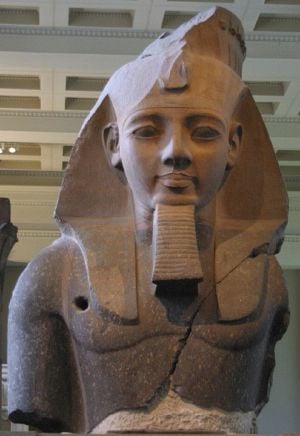Giovanni Battista Belzoni

Giovanni Battista Belzoni (November 15 1778 – December 3, 1823) was an Italian explorer of Egyptian antiquities.
Belzoni was born at Padua, the son of a barber. His family was from Rome, and he spent his adolescence there. He intended taking monastic orders, but in 1798 the occupation of the city by the French troops drove him from Rome and changed his proposed career. He went back to Padua, where he studied hydraulics, moved in 1800 to the Netherlands.
In 1803 travelled to England, where he married an Englishwoman, Sarah Bane or Banne. He stood 6 ft 7 in (2 metres tall), broad in proportion, and his wife was of equally generous build. They were for some time compelled to find subsistence by exhibitions of feats of strength and agility as a strongman, at fairs and on the streets of London. Through the kindness of Henry Salt, the traveller and antiquarian, who was ever afterwards his patron, he was engaged at Astley's amphitheatre, and his circumstances soon began to improve.
In 1812 he left England, and after travelling in Spain and Portugal reached Egypt in 1815, where Salt was then British consul-general. Belzoni wanted to show Mehemet Ali a hydraulic machine of his own invention for raising the waters of the Nile. Though the experiment with this engine was successful, the design was abandoned by the pasha, and Belzoni resolved to continue his travels. On the recommendation of the orientalist, J. L. Burckhardt, he was sent by Salt to the Ramesseum at Thebes, whence he removed with great skill the colossal bust of Ramesses II, commonly called "the Young Memnon" – shipped by Belzoni to England, this piece is still on prominent display at the British Museum. He also pushed his investigations into the great temple of Edfu, visited Elephantine and Philae, cleared the great temple at Abu Simbel of sand (1817), made excavations at Karnak, and opened up the sepulchre of Seti I (still sometimes known as "Belzoni's Tomb"). He was the first to penetrate into the second pyramid of Giza, and the first European in modern times to visit the oasis of Bahariya, which he supposed to be that of Siwa. He also identified the ruins of Berenice on the Red Sea.
In 1819 he returned to England, and published in the following year an account of his travels and discoveries entitled Narrative of the Operations and Recent Discoveries within the Pyramids, Temples, Tombs and Excavations in Egypt and Nubia, &c. He also exhibited during 1820–1821 facsimiles of the tomb of Seti I. The exhibition was held at the Egyptian Hall, Piccadilly, London. In 1822 Belzoni showed his model in Paris.
In 1823 he set out for West Africa, intending to travel to Timbuktu. Having been refused permission to pass through Morocco, he chose the Guinea Coast route. He reached Benin, but was seized with dysentery at a village called Gwato, and died there. According to the celebrated traveller Richard Francis Burton he was murdered and robbed. In 1829 his widow published his drawings of the royal tombs at Thebes.
Reference
This article incorporates text from the Encyclopædia Britannica Eleventh Edition, a publication now in the public domain.
Credits
New World Encyclopedia writers and editors rewrote and completed the Wikipedia article in accordance with New World Encyclopedia standards. This article abides by terms of the Creative Commons CC-by-sa 3.0 License (CC-by-sa), which may be used and disseminated with proper attribution. Credit is due under the terms of this license that can reference both the New World Encyclopedia contributors and the selfless volunteer contributors of the Wikimedia Foundation. To cite this article click here for a list of acceptable citing formats.The history of earlier contributions by wikipedians is accessible to researchers here:
The history of this article since it was imported to New World Encyclopedia:
Note: Some restrictions may apply to use of individual images which are separately licensed.